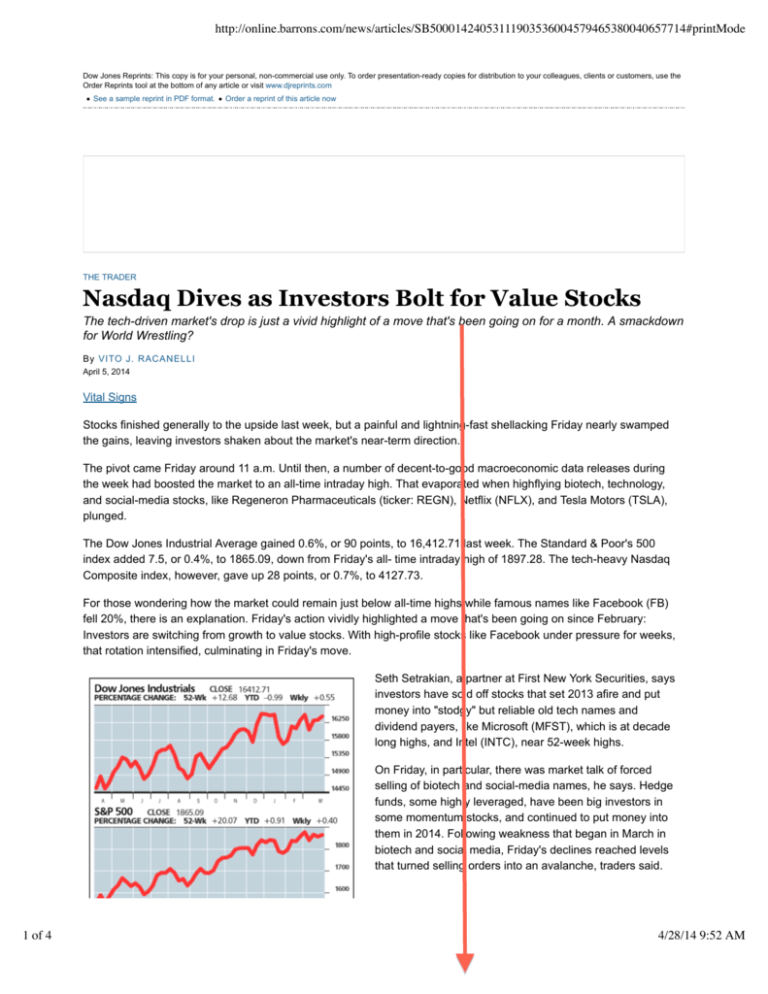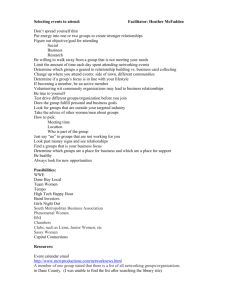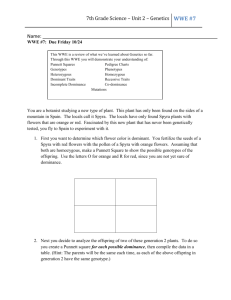
http://online.barrons.com/news/articles/SB50001424053111903536004579465380040657714#printMode
Dow Jones Reprints: This copy is for your personal, non-commercial use only. To order presentation-ready copies for distribution to your colleagues, clients or customers, use the
Order Reprints tool at the bottom of any article or visit www.djreprints.com
See a sample reprint in PDF format.
Order a reprint of this article now
THE TRADER
Nasdaq Dives as Investors Bolt for Value Stocks
The tech-driven market's drop is just a vivid highlight of a move that's been going on for a month. A smackdown
for World Wrestling?
By VITO J. RACANELLI
April 5, 2014
Vital Signs
Stocks finished generally to the upside last week, but a painful and lightning-fast shellacking Friday nearly swamped
the gains, leaving investors shaken about the market's near-term direction.
The pivot came Friday around 11 a.m. Until then, a number of decent-to-good macroeconomic data releases during
the week had boosted the market to an all-time intraday high. That evaporated when highflying biotech, technology,
and social-media stocks, like Regeneron Pharmaceuticals (ticker: REGN), Netflix (NFLX), and Tesla Motors (TSLA),
plunged.
The Dow Jones Industrial Average gained 0.6%, or 90 points, to 16,412.71 last week. The Standard & Poor's 500
index added 7.5, or 0.4%, to 1865.09, down from Friday's all- time intraday high of 1897.28. The tech-heavy Nasdaq
Composite index, however, gave up 28 points, or 0.7%, to 4127.73.
For those wondering how the market could remain just below all-time highs while famous names like Facebook (FB)
fell 20%, there is an explanation. Friday's action vividly highlighted a move that's been going on since February:
Investors are switching from growth to value stocks. With high-profile stocks like Facebook under pressure for weeks,
that rotation intensified, culminating in Friday's move.
Seth Setrakian, a partner at First New York Securities, says
investors have sold off stocks that set 2013 afire and put
money into "stodgy" but reliable old tech names and
dividend payers, like Microsoft (MFST), which is at decade
long highs, and Intel (INTC), near 52-week highs.
On Friday, in particular, there was market talk of forced
selling of biotech and social-media names, he says. Hedge
funds, some highly leveraged, have been big investors in
some momentum stocks, and continued to put money into
them in 2014. Following weakness that began in March in
biotech and social media, Friday's declines reached levels
that turned selling orders into an avalanche, traders said.
1 of 4
4/28/14 9:52 AM
http://online.barrons.com/news/articles/SB50001424053111903536004579465380040657714#printMode
Many of the stocks punished since February are 2013
momentum plays, which went one-way last year: up, says
Sal Arnuk, a partner at Themis Trading. "When the mo'
turns," he adds, it can mean a quick drop.
Monday promises to be interesting, and the life of this selloff
might be measured by what happens to the old tech stocks
and high-dividend yielders that have so far been a refuge
for investors.
Dunkin' Brands Group has shown seemingly good earnings
growth recently. That, and plans to expand a relatively small
brand beyond its core east of the Mississippi have boosted
shares. The stock is up almost 50% since 2012, to $48.48
Friday, topping the market's 31% run in that period.
With a $5.3 billion market cap, Dunkin' (ticker: DNKN)
sports almost 11,000 mostly franchised outlets, as well as
7,300 Baskin & Robbins ice cream stores, though the
latter's weak returns aren't part of the bull story. Net income
rose 35% in 2013 to $146.9 million from $108 million in 2012, which in turn rose over 200% from $34 million in 2011.
Dunkin' plans to build 380 to 410 net new stores this year, many of them in the Midwest and Western U.S.
Yet a closer look at earnings and its expansion should make investors wonder if the valuation has gotten ahead of
reasonable expectations. Dunkin' trades at 27 times this year's consensus EPS estimate of $1.82, a big jump from
2013's $1.36. That's a price/earnings ratio higher than its historical median and above P/Es of bigger and betteroperated quick-service restaurants.
What about that earnings growth? According to a recent report from New Constructs, an independent research outfit,
Dunkin's growth has been briefly enhanced by a few one-time events. A chunk of 2012 growth came thanks to some
$70 million in one-time 2011 expenses—about 16% of the total—which sharply depressed 2011's results, the report
notes. Similarly, 2013 was boosted by $32 million in one-time reductions of revenue and expenses in 2012.
Adjusting for those items, after-tax net operating profit grew 30% in 2012 and 7% in 2013—good but not deserving of
such a multiple, New Constructs wrote. Dunkin's return on invested capital is a paltry 8.5%, much lower than its
peers, and suggests it isn't in a strong position to expand.
Moreover, the expected earnings per share jump in 2014 seems too
optimistic. For example, Dunkin's domestic same-store sales—71% of
outlets are in the U.S.—have dropped steadily over the past three years to
3.4% in 2013, from 4.2% and 5.1% in 2012 and 2011, respectively. The
stock has risen, but the 2014 consensus EPS has been stuck at $1.82 for
nearly a year.
Dunkin' hasn't been building in its newer regions as fast as planned,
according to Alton Stump, an analyst with Longbow Research. He says his
industry channel checks show Dunkin' is missing new-region store targets
and offsetting that by beating targets in core geographic areas on the East
Coast. The Atlantic coast of Florida, a state that provides 7% of the U.S.
store base, faces an overbuild threat, with same-store sales there having
decelerated to 6% to 7% from 8% to 9%, he adds.
This raises a risk of cannibalization, adds Stump, who has a $35 target on the stock. Dunkin's multiple could come
under pressure if companywide same-store sales continue to decelerate. Another issue, Stump adds, is that coffee, a
2 of 4
4/28/14 9:52 AM
http://online.barrons.com/news/articles/SB50001424053111903536004579465380040657714#printMode
high-margin product that generates 70% of sales in the New England market, represents less than 40% of store level
sales outside Dunkin's core region—and 30% in some newer areas.
In response to a request for comment, a Dunkin' spokesperson directed Barron's to a recent company presentation.
In it, the company expects $1.79 to $1.83 EPS this year and 3% to 4% comparable-store growth for Dunkin's U.S.
stores.
High expectations are built into the stock price. If missed, the stock is going to pay.
Another top performer facing potential cannibalization risk is World Wrestling Entertainment (WWE), whose shares,
which closed at $28.02 Friday, have about tripled since the fall, trouncing the 9% bull market rise over the same
period. Why the excitement about a firm in which revenue and profit growth have been poor recently and lackluster
longer-term?
It derives mostly from the February launch of its own digitally delivered network for WWE's popular wrestling
entertainment programming. Management predicts it can "double or triple" the $63.2 million 2012 operating income
before depreciation and amortization (Oibda) results by 2015. In 2013, Oibda fell to $30.4 million.
The market has bought the company argument enthusiastically, but there are reasons to be skeptical. For $9.99 per
month—down from $12.99 to $14.99 originally—fans get "all you can eat" wrestling programs 24/7, including the
lucrative 12 or so annual WWE pay-per-view events that separately would normally cost $45 to $60 per event.
WWE figures the new network could ultimately attract two to three million subscribers domestically, suggesting, at
$120 per subscriber, some $240 million to $360 million in "extra" revenue per year. Given WWE has been around
$500 million in sales since 2007, it's no wonder the stock popped.
Analysts upped their EPS estimates to $1.53 in 2015. WWE's net income last year was $2.8 million or four cents a
share, and $31.4 million or 51 cents in 2012. WWE shares are trading at a rich P/E ratio of 24 times projected 2015
EPS, but analysts expect a one-cent EPS loss this year. For the record, the trailing P/E is 700 times.
Bearish considerations are getting short shrift. First, WWE is betting its new network revenue will offset a likely drop
or loss of PPV sales—$82.5 million last year—but that will happen only if it gets to subscriber targets.
Then there are new and significantly higher costs in setting up a 24/7 network versus PPV. Analysts see a 2014 loss
for a reason. WWE has already guided to a first quarter 2014 net loss of $12 million to $15 million from launch costs.
The stock is challenging at this point, says Alan Lancz, whose eponymous firm sold out of WWE recently. How much
cannibalization there will be is unknown, he says, and the stock price discounts the success of what is a fledgling
network, exposing shareholders to execution risk.
Potential cannibalization of live-event ticket sales, $111.5 million last year, is something no one is talking about.
Together with PPV, that's about $200 million in revenue, 40% of total sales, and a good portion of the predicted but
not-yet-seen new revenue. The network should draw subscribers both from the live events and the PPV fan base,
which has some overlap. If a subscriber has 24/7 wrestling on his laptop or TV at home for just a few dollars a month,
there's considerably less incentive both for the subscriber and his friends to spend on PPV or a $75 live wrestling
match ticket.
Other broadcast networks love WWE programing but won't they be hesitant in the future to pay up when it's available
24/7 on WWE's own network? Investors don't seem to be pricing in bearish factors. Given weak revenue growth since
2007—a considerable period—the market could be overestimating WWE's ultimate appeal.
Investors might be confusing the raving loyalty of its fans—its events consistently get among the best TV
ratings—with WWE growth possibilities, that is, appealing to new fans. The network is a different way of reaching
current hardcore fans. While it might attract new ones, that's far from the slam dunk that the stock's rise discounts.
We also have our doubts that WWE's international appeal will meet rosy expectations.
3 of 4
4/28/14 9:52 AM
http://online.barrons.com/news/articles/SB50001424053111903536004579465380040657714#printMode
In an interview, WWE's chief strategy and financial officer, George Barrios, disputes our valuation skepticism, likening
its digital network to those of global content distributors like Netflix. After the U.S., the digital network will be ready in
the U.K. and Nordic countries by late 2014 or early 2015, he adds.
As for cannibalization, WWE expects $50 million to $150 million in OIBDA if two million to three million subscribers
sign up, and that assumes PPV revenue goes away. Barrios notes that content costs for the network are higher than
for PPV, but adds that at a million subs, the network is at break-even. WWE will release initial subscriber numbers
Monday, April 7. He wouldn't comment on continuing negotiations with broadcasters.
If Monday's number is big, the stock might pop again, but it's the hardcore who will sign up first. Longer-term, it's
unclear that the two million to three million number will be reached. There's a lot of momentum behind the stock and it
could go higher for a short time, Lancz notes, but the risk and reward equation is no longer favorable.
E-mail: vito.racanelli@barrons.com
Copyright 2013 Dow Jones & Company, Inc. All Rights Reserved
This copy is for your personal, non-commercial use only. Distribution and use of this material are governed by our Subscriber Agreement and by copyright law. For non-personal
use or to order multiple copies, please contact Dow Jones Reprints at 1-800-843-0008 or visit
www.djreprints.com
4 of 4
4/28/14 9:52 AM






